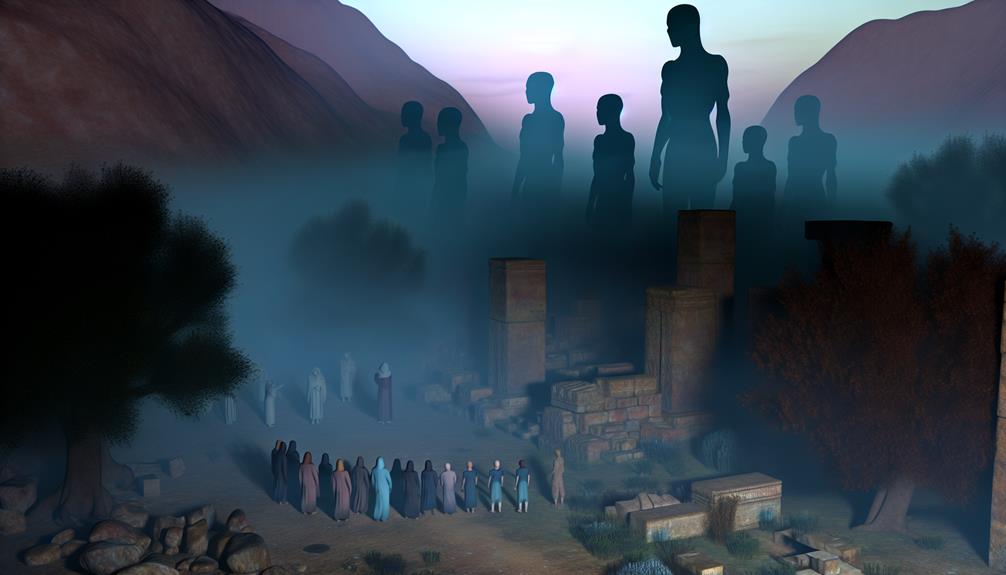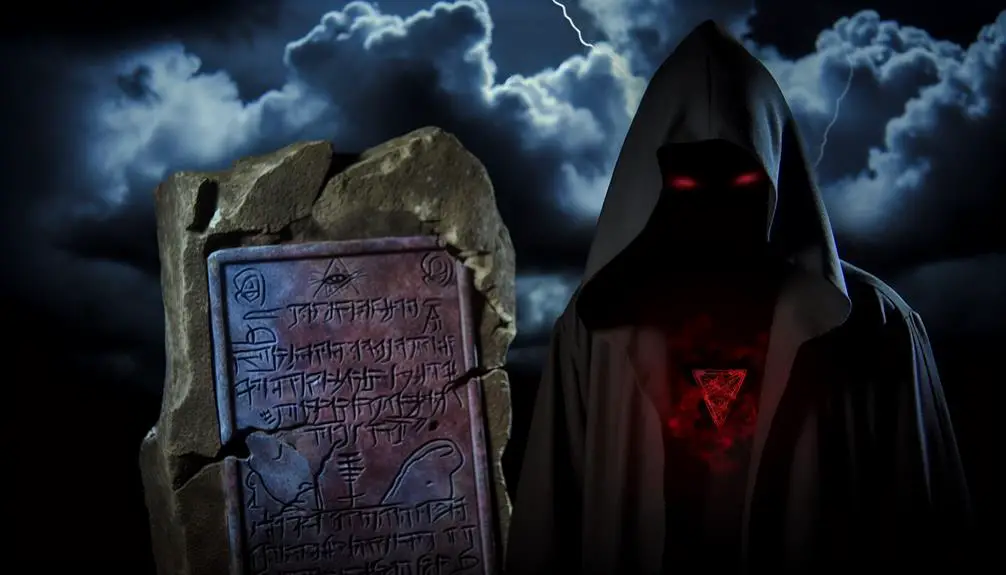Step into the shadows of biblical history to unravel mysteries that have puzzled scholars for centuries, where every clue leads to deeper intrigue.

Mysteries in the Bible
Just as an archaeologist brushes away centuries of dust to uncover hidden treasures, you stand on the precipice of exploring some of the Bible's most profound mysteries.
From the enigmatic Nephilim, whose origins spark debate among scholars, to the lost Ark of the Covenant, a sacred artifact that has eluded discovery for millennia, the stories you're about to engage with are steeped in intrigue.
Add to these the identity of the Antichrist, the apocalyptic secrets, and the enigma of the Shroud of Turin, and you have a tapestry of puzzles that has fascinated believers and skeptics alike.
Let's embark on this journey together, where each mystery invites more questions than answers, igniting a curiosity that's as ancient as the texts themselves.
Key Takeaways
- Biblical texts contain enigmatic figures like the Nephilim, blending divine and human elements.
- The location of the Ark of the Covenant, a symbol of divine-human covenant, remains unknown.
- The identity of the Antichrist embodies evolving interpretations of evil opposing spiritual truth.
- Revelations' apocalyptic symbolism, including the Four Horsemen and Seven Seals, continues to challenge and intrigue scholars.
The Enigma of the Nephilim

Within the ancient texts of the Bible, the Nephilim stand as a mysterious and often debated entity, sparking both curiosity and scholarly investigation. You've likely encountered references to these beings, whose very existence intertwines notions of giant origins with angelic descent. This fusion of the earthly and the divine prompts a deeper dive into their enigmatic nature.
The term 'Nephilim' is often translated to mean 'giants,' a depiction that aligns with their portrayal as beings of great size and strength. This interpretation suggests a physical manifestation of their extraordinary origins, setting them apart from ordinary mortals. Yet, the aspect of angelic descent introduces a more complex layer to their identity. Biblical texts hint at the Nephilim being the offspring of 'the sons of God' and 'the daughters of men,' suggesting a union between celestial beings and humans. This hybrid lineage positions the Nephilim at a crossroads of the divine and the earthly, embodying characteristics of both realms.
Analyzing these narratives, one must navigate the fine line between myth and historical interpretation. The scholarly pursuit to unravel the mystery of the Nephilim's existence and their role within biblical lore continues to challenge and fascinate.
The Lost Ark of the Covenant
Among the most compelling artifacts mentioned in the Bible, the Ark of the Covenant represents a profound mystery, encapsulating the convergence of divine presence and historical intrigue. This sacred chest, believed to have been constructed approximately 3,000 years ago, served as a tangible symbol of the Covenant between God and the Israelites. Yet, its exact location remains one of the greatest unsolved mysteries in biblical archaeology.
Several theories about the Ark's location have emerged over centuries, sparking intense debate and exploration:
- Ethiopia: Tradition holds that the Ark resides in the Church of Our Lady Mary of Zion.
- Egypt: Some believe it was hidden in a temple in Tanis, made famous by popular culture.
- Jerusalem: Theories suggest it might be buried underneath the Temple Mount.
- Unknown: Others argue the Ark was either destroyed or remains hidden in a location yet to be discovered.
The Covenant purpose of the Ark, to serve as a physical manifestation of God's promise and presence, underscores its spiritual and historical significance. Despite extensive searches and scholarly research, the Ark's final resting place continues to elude discovery, leaving its mystery intact and fueling ongoing fascination and speculation.
The Identity of the Antichrist

ARTICLE TITLE: Mysteries in the Bible
PREVIOUS SUBTOPIC: 'The Lost Ark of the Covenant'
CURRENT SUBTOPIC: 'The Identity of the Antichrist'
Shifting focus from the tangible mysteries of biblical artifacts, such as the Ark of the Covenant, we encounter the enigmatic concept of the Antichrist, a figure shrouded in prophetic ambiguity and theological debate. The identity of the Antichrist has been a topic of intense scrutiny and speculation throughout the ages, with interpretations evolving alongside historical and cultural shifts.
Aspect |
Discussion |
|---|---|
Historical Interpretations |
Historically, the Antichrist has been seen as a personification of ultimate evil, opposing Christ and misleading humanity. Early Christian texts and theologians speculated about this figure, often associating it with political or religious adversaries of the time. |
Modern Speculations |
In modern times, interpretations have expanded to include systemic evils, such as corrupt institutions or ideologies that lead people away from spiritual truth. The focus has shifted from identifying a singular Antichrist to understanding the broader concept of antichristian forces at work in the world. |
This scholarly exploration avoids pinpointing a specific entity as the Antichrist, acknowledging the complexities and varied perspectives that have shaped this intriguing biblical mystery.
The Secrets Behind the Apocalypse
Delving into the secrets behind the Apocalypse, scholars examine the Book of Revelation to uncover the nuanced and often symbolic prophecies that have puzzled theologians for centuries. The vivid imagery and complex symbolism within its pages have led to a myriad of interpretations, but a few key themes consistently emerge as central to understanding the Apocalypse:
- The Four Horsemen: Often seen as harbingers of calamity, these figures symbolize conquest, war, famine, and death. Their arrival marks the beginning of the end times, serving as a warning to humanity about the consequences of its actions.
- The Seven Seals: The breaking of these seals by the Lamb is a core element, each unveiling a different aspect of the Apocalypse. They represent divine judgment and the sequential unfolding of events leading to the end of the world.
- Symbolism of Numbers: Numbers like seven, ten, and twelve carry deep symbolic meaning, often representing completeness, divine order, or governmental perfection.
- The Battle of Armageddon: This climactic battle between good and evil is anticipated as the final showdown, where the forces of darkness will be defeated.
These elements, while shrouded in mystery, provide a framework for interpreting the Apocalypse's message and its implications for both the ancient and modern world.
The Mystery of the Shroud of Turin

The Shroud of Turin captivates scholars and believers alike with its enigmatic presence, believed by many to be the burial cloth of Jesus Christ. Its mystery lies not only in its haunting image, which appears to detail the face and body of a crucified man, but also in the ongoing debate over its historical authenticity. You're drawn into a complex puzzle, where science and faith intersect, challenging the very foundations of what you might accept as truth.
Radiocarbon dating has played a pivotal role in this debate. In the late 20th century, scientists conducted tests that suggested the shroud was created in the medieval period, centuries after the death of Christ. This finding threw the shroud's authenticity into question, yet it didn't close the case. Critics argue that the samples tested could have been contaminated, or not representative of the whole cloth, urging for more comprehensive studies.
Your understanding of the Shroud of Turin is thus mired in ambiguity. Despite advances in technology, the shroud remains a relic shrouded in mystery, straddling the line between revered religious artifact and historical anomaly. Its true origin and the identity of the man it might depict continue to elude definitive explanation, leaving you to ponder the limits of scientific inquiry and the depths of faith.
Frequently Asked Questions
How Were the Pyramids of Egypt Referenced or Connected to Biblical Narratives?
You might be curious about how pyramid construction and ancient allegories intertwine with biblical narratives. While the Bible doesn't directly mention the building of the Egyptian pyramids, it's fascinating to explore potential connections.
Scholars analyze texts for indirect references or allegorical interpretations that could link these monumental structures to biblical stories. This scholarly, unbiased approach helps uncover the rich tapestry of ancient history and its potential intersections with biblical events.
What Is the Significance of the Number 40 in Various Biblical Stories?
In your journey through biblical stories, the number 40 often emerges as a beacon of transformation and trial. This number isn't just a tally; it's drenched in rain symbolism and heralds covenant renewal.
From the 40 days of deluge that Noah endured to Moses's 40 years in the desert, each narrative stitches a pattern of purification, testing, and preparation for a new chapter. Analyzing these tales, you'll uncover a tapestry of divine intention and human perseverance.
How Did Different Languages Originate According to the Bible, and What Is the Story Behind the Tower of Babel?
You're looking at how different languages originated, focusing on cultural diversity and linguistic evolution.
The Bible presents the Tower of Babel story, where humanity's single language fragmented into many. This tale illustrates divine intervention to scatter people across the earth, promoting both cultural diversity and linguistic evolution.
It's a pivotal narrative underscoring the origins of languages, emphasizing the role of divine action in creating the rich tapestry of human communication.
In the Bible, Are There Any Mentions or Implications of Life Existing Outside of Earth?
Diving into the cosmic ocean of texts, you won't find explicit mentions of extraterrestrial life as you might hope. However, interpretations of 'alien angels' or 'cosmic battles' suggest some believers see hints of life beyond Earth.
Analyzing these passages, though, requires a scholarly, unbiased lens. The Bible doesn't straightforwardly discuss otherworldly life, but through metaphor and allegory, some infer its existence amidst celestial narratives.
What Are the Biblical Explanations for the Existence of Dinosaurs and Why Are They Not Explicitly Mentioned in the Scriptures?
You're exploring why dinosaurs aren't directly mentioned in the scriptures and their biblical explanations. Scholars suggest that ancient texts like Job may indirectly reference creatures like dinosaurs through Job's Behemoth and Leviathan's description. These passages are often debated for their ambiguity and potential allegorical meanings rather than explicit mentions.
The absence of clear references might be due to the texts' focus on human and spiritual narratives, rather than cataloging all of Earth's history.
Conclusion
As you've journeyed through the labyrinth of biblical enigmas, from the towering shadows of the Nephilim to the ethereal whispers of the Apocalypse, you've navigated a realm where divine mysteries and human curiosity intertwine.
The Ark's elusive trail, the Antichrist's veiled identity, and the Shroud's silent testimony weave a rich tapestry of scholarly intrigue. These mysteries, cloaked in antiquity, invite a continuous quest for understanding, illuminating our quest with the flickering torch of analysis, unmarred by bias.



Sign up